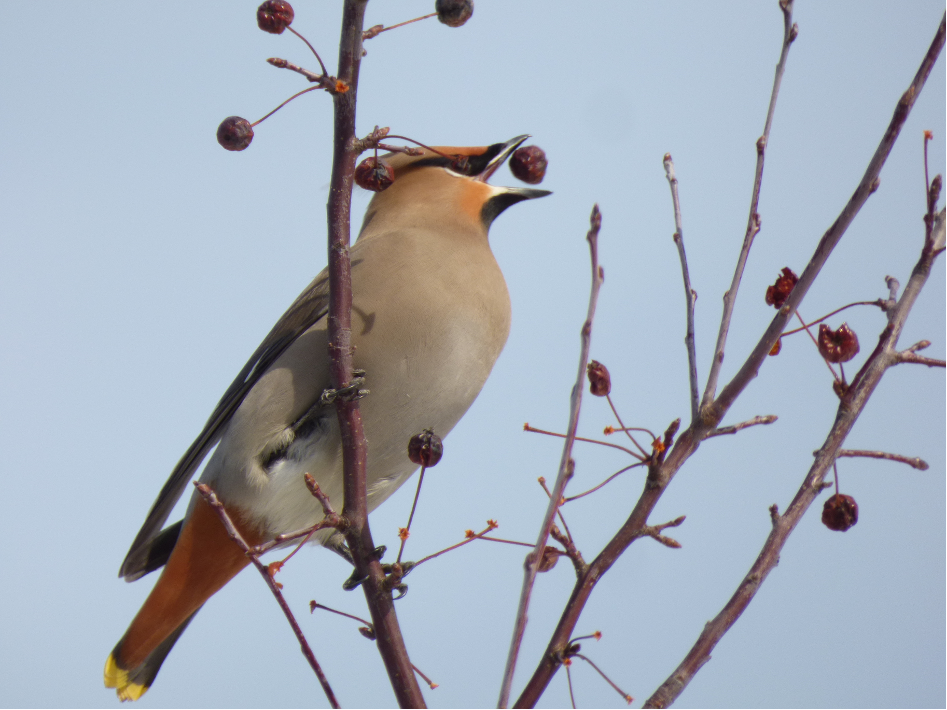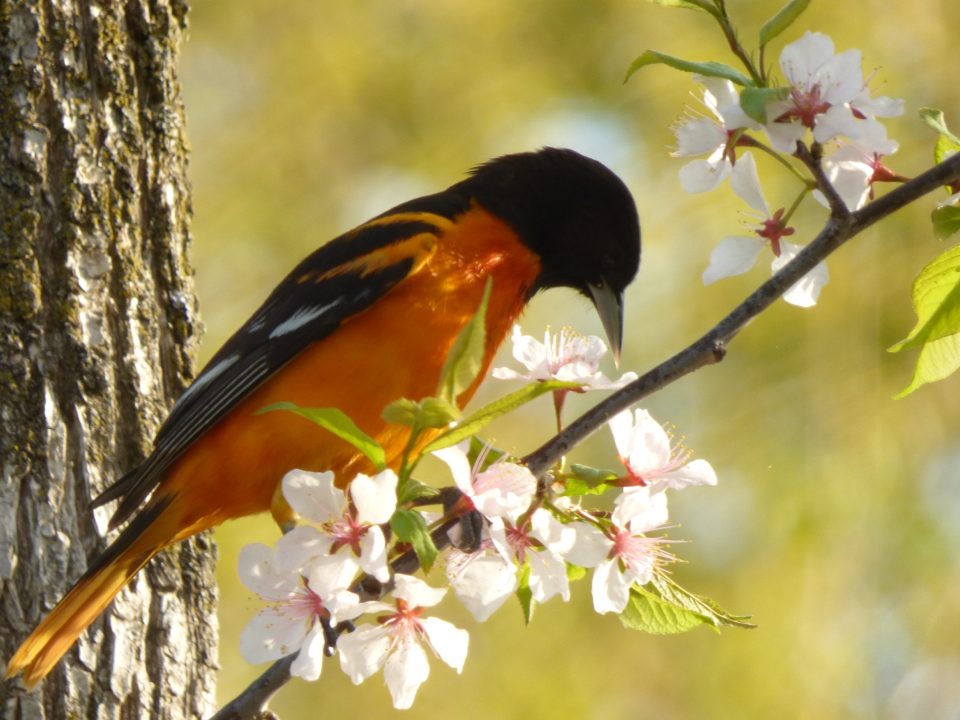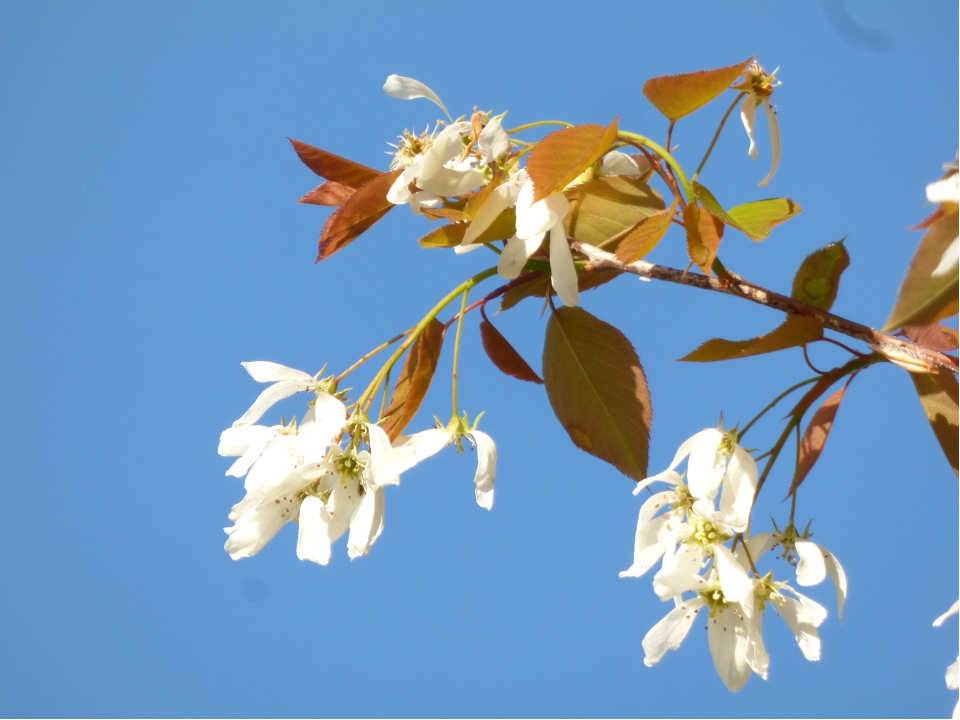Bird Friendly Habitat
We rarely see anything out of order in a park: the grass is mown, the trees are evenly spaced to provide spots of sun and shade alike, and the small shrubs are neatly trimmed. Parks, gardens, and lawns are all tailored for human use, kept clean and tidy. Yet the nature that many animals are used to and rely on is wild. It is a messy entanglement of twigs, branches, and vines. If you have ever tried walking through a forest where the grass was up to your knees and you found yourself being tugged at by thorns, falling over stumps you didn’t see, and covered by inexplicably sticky substances, then you have experienced nature the way many wild animals do.
This past summer, I spent a lot of time hiking through the forests on the West Island of Montreal. I am not talking about the trails carved out in Parc Cap-Saint-Jacques or even the rougher trails in l’Anse-a-l’Orme Park, but the wilder areas in Montreal’s protected forests, namely the greenspaces in the future Grand-Parc-de-l’Ouest. While there are times when I cursed the thorny plants and the tangles of vines, there were also many magical moments I could not experience anywhere else. One day, for example, a fox rushed through a cluster of shrubs before it spotted me and swiftly skittered away. Another day, juvenile coyotes were huddled beside their parents as they howled at three young deer standing still mere metres away. And on many occasions, I saw the same young red-tailed hawk with its two parents circling the quiet fields of Parc Bois-de-la-Roche. Moments like these are only captured in the untamed places of nature, places that somehow exist away from the public eye yet right here on our island.
Animals of all kinds depend on the goods that nature provides. Birds especially take from habitats across many different ecosystems, even across continents. They use parks like you see in Montreal to refuel during migration, to breed in summer, or to reside year-round. Birds need places where they have access to both food and nesting materials. Areas where branches of hawthorn and buckthorn are all cramped together and vines like the Virginia creeper and trumpet honeysuckle climb between them. It may seem messy and unruly to humans, but it is full of resources for birds. Below are brief descriptions of some of the plants that you may see in the wilder spots of the city; plants that may not be purposefully planted but their presence is greatly appreciated by our resident birds.
A feast: Plants for eating
When it comes to eating, many birds are generalists. Whether they eat fruits or nectar or seeds, many will take from any type of tree, shrub, or vine. Some of these plants are native to North America while others are introduced or even invasive. For example, the common buckthorn is an exotic species from Eurasia, now naturalized in North America, which produces berries that many birds love. Yet buckthorns disrupt the natural ecosystem by forming dense monocultures that exclude many important native plants. While exotic species such as buckthorns should not be planted and often need to be controlled, there is still a need to acknowledge how naturalized species such as this can contribute to the environment. Below are some examples of plants that provide food for birds in the Grand Parc de l’Ouest.

Virginia creeper (Parthenocissus quinquefolia) is a vine native to the United States and southern Ontario, but not to Quebec. As an introduced plant, Virginia creeper has colonized many habitats. It is quite easy to recognize due to its iconic five-lobed leaves (hence its Latin name). This vine produces small blue berries which, although beneficial for birds, are not edible for humans. Virginia creeper is a versatile plant, growing from many types of soil and climbing on anything nearby: other plants, buildings, or just along the ground. Birds like chickadees, white-breasted nuthatches, thrushes, and catbirds forage on these berries from fall through winter.
Eastern buttonbush (Cephalanthus occidentalis) is a tall shrub native to North America, often growing to a height of 2 to 4 meters. Eastern buttonbush has small, white to pale-pink flowers arranged in dense heads that look like pincushions. These flowers bloom in June and August and, when fertilized, produce achenes/nutlets in September and October which can persist through winter. Eastern buttonbush is a wetland shrub found in swamps, marshes, bogs, and along the edges of rivers. It is therefore primarily consumed by ducks and shorebirds. This plant does not only benefit birds; its pollen and nectar also provide lots of nutrition to wild bees.

Elderberries (Sambucus spp. ) are large native shrubs. You can find elderberries in moist sunny areas, usually on the edge of forests. Small white flowers bloom in June and appear in clusters along its branches. Fertilized plants produce red or purple berry-like drupes that are favoured by frugivorous birds like Hermit thrushes and Gray catbirds in August and September. The sweet taste of elderberries is also enjoyed by people in juices and desserts, and elderberries are medicinally valuable in treating asthma, colds, constipation, and arthritis (Jensen et al., 2001).
Oaks (Quercus spp.) are among the most iconic trees in North America. The three most common native oak species in Montreal range from shorelines (bur oak; Quercus macrocarpa) to moist woodlands (white oak; Quercus alba ) and drier uplands (red oak; Quercus rubra). All are also commonly planted in suburban communities and green spaces because they are tall, sturdy and very attractive to wildlife. Oak trees produce tiny flowers borne in catkins that bloom in spring (March to May). These result in acorns (or nuts), feasted upon by squirrels but also a favourite among some birds like woodpeckers, mallards, and blue jays.
Hawthorn (Crataegus spp .) trees can be found across southern Canada. Hawthorns are famous for two things; (1) they have painful thorns and (2) individual species are difficult to identify. While their pointy thorns can inflict a painful scratch, small birds can easily avoid them. And it is certainly worth it to brave the hawthorn’s branches as, among the thorns, birds will find red berries that often persist through winter and into spring, providing food when few other resources are available. You might see Swainson’s thrushes, black-capped chickadees, or even wild turkeys feeding from hawthorn trees. They grow in dense thickets at the edge of forests so be careful if you decide to take a stroll in the woods.
A home: Plants for nesting
Spring is famously the season when we see flowers blooming and hear birds singing. Migratory birds have returned to their breeding grounds where they will mate, nest, and rear their young in late spring and summer. But first, birds need to find or create a safe and cozy home for their eggs. Prospective parents build nests in trees, shrubs, grasslands, and even human-built structures. In many cases, soft plant material is an important part of nest construction.

Eastern cottonwood (Populus deltoides) trees are best known for the cottony (comose, i.e. hairy) seeds that females produce in capsules during late March and early April. In fact, if you live in an area with lots of Eastern cottonwoods, you would probably have seen clouds of cotton drifting through the air in spring. Eastern cottonwood leaves are easy to recognize; they have a triangular shape like a deltoid (hence its Latin name). Some raptors, like hawks, build their nests directly on the branches of lone cottonwood trees. These trees are most commonly found along stream banks and other low-lying areas. Birds frequent these areas and use cotton from Eastern cottonwoods when building their nests in early spring.
Black willow (Salix nigra) is the largest native willow tree and provides ideal nesting sites for birds. A fast-growing, tall, but short-lived tree (65 years), it is typically found along river and lake shorelines, including Lake of Two Mountains and Lake Saint-Louis surrounding the West Island of Montreal. Like many willows, it has long leaves that can conceal nesting birds from predators. Many cavity-nesting birds, like yellow-bellied sapsuckers, tear at the soft bark to make nests. Black willows also exhibit a ‘witch’s broom’ growing habit which means that their shoots grow in dense clusters on their branches; perfect structures for nest-building. In spring, female trees produce seeds with silky hairs that are dispersed by wind. The soft, fluffy seeds are also used by birds as nesting material.
Eastern red cedar (Juniperus virginiana), despite its name, is a species of juniper. Native to North America, Eastern red cedar is an evergreen tree that provides year-round concealment for birds. Northern cardinals and song sparrows take advantage of the dense branches to build sheltered nests. Eastern red cedars bloom from March to May, producing small green/brown flowers that become blue berries in summer. The cedar waxwing, in fact, got its name by favouring these Eastern red cedar berries. Red cedar also provides food in the form of larvae as it is a host to many Lepidoptera species in spring. Not only a haven from predators and a source of food; Eastern red cedars also have soft bark that birds can strip into nesting materials.
Winterberry (Ilex verticillata) is a shrub native to eastern Canada. Standing at 2 to 3 meters tall, winterberries are some of the taller plants on shorelines. In spring and summer, they produce small white flowers that, after fertilization, become bright red berries. Like Eastern cottonwoods, winterberries can be either male or female and must grow together in order to produce fruit. The berries grow in dense clusters that persist through winter and into spring, providing food at a time when fruits are scarce. Winterberries also host several Lepidoptera species so, in spring, there are many larvae for birds to eat. American robins, for example, eat berries and larvae found within the branches of winterberries. The dense shrubs offer them a convenient source of shelter and food; an ideal spot to nest in.
Various species of serviceberry (Amelanchier spp.) are found across much of Canada. Although serviceberries often have a shrubby growth structure, some can grow to 5-8 m tall. White flowers bloom in spring so that their berries are ready to be eaten by nesting birds. Many birds build their nests in serviceberries as the tree’s multi-branching habit creates a convenient foundation for a nest and provides concealment from predators. Like the Eastern red cedar, serviceberries are host to many Lepidoptera species whose larvae are eaten by birds in spring. You might see Baltimore orioles, Eastern bluebirds, or Mourning doves nesting in serviceberries within open fields, rocky slopes, forest edges, or along streams.
In this article, I presented you with only a few plants that birds use to nest and feed themselves while in Montreal, but there are many more native species that benefit the wildlife in our city: dogwoods, mountain-ash, cherries (chokecherry, pin cherry, black cherry), nannyberry, and white cedar, to name a few. Although each individual plant is important in making a nest or as a source of food, the composition of these plants together is just as important. A lone serviceberry, for example, is not as ideal as a serviceberry surrounded by many dogwood, hawthorn, and crabapple trees. A layered landscape provides extra shelter from predators and abundant sources of food at a time when birds are looking to rest or raise their young. Wild areas provide these extra resources and security which turn a simple nest or resting place into a home. So, the next time you pass by one of the less traditionally beautiful areas in the city, imagine the multitudes of life that call it home.

If you are interested in contributing to the landscape of friendly plants in Montreal, you may consider planting these species in your own backyard:
· Sunflowers (Helianthus spp. )
· Staghorn Sumac (Rhus typhina )
· Chokeycherry (Prunus virginiana )
· Red-osier dogwood (Cornus sericea )
· Arctic raspberry (Rubus arcticus )
· Nannyberry (Viburnum lentago )
· Blue vervain (Verbena hastata )
· Highbush cranberry (Viburnum opulus )
· Soft rush (Juncus effusus )
· Canada lily (Lilium canadense )
References
Canadensys. Vascan: Plant Database. Accessed on March 28, 2022. Retrieved from https://data.canadensys.net/vascan
Exploring Birds. Attracting Bird with Native Plants. Accessed on March 28, 2022. Retrieved from https://www.exploringbirds.com/categories/attracting-bird-with-native-plants
Jensen, K., Christensen, L. P., Hansen, M., oslash, rgensen, U. and Kaack, K. (2001). “Olfactory and quantitative analysis of volatiles in elderberry Sambucus nigra L juice processed from seven cultivars.” Journal of the Science of Food and Agriculture 81: 237‐244.
The University of Texas at Austin. Lady Bird Johnson Wildflower Center: Plant Database. Accessed on March 28, 2022. Retrieved from https://www.wildflower.org/plants
Stoner, Derek. Native Plants for Nesting Birds: Top 12 picks. Choose Natives: Plant for Life. Accessed on March 28, 2022. Retrieved from https://choosenatives.org/articles/native-plants-nesting-birds-top-12-picks/
Boydell, John. 2017. Increase the numbers of birds, bees, and butterflies by growing Quebec’s plants. Love of Nature Frontyard Restoration. Retrieved from https://frontyardrestoration.com/uploads/3/5/5/3/35532620/guidepq.pdf